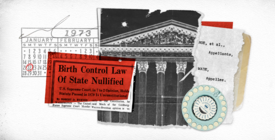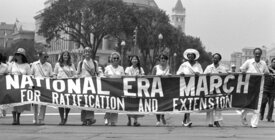On his first day in office, President Trump issued an executive order attempting to end the 14th Amendment’s guarantee of birthright citizenship. State attorneys general, civil rights organizations, and immigrant rights groups soon filed lawsuits challenging the order in federal courts around the country. Here’s what to know about birthright citizenship ahead of Supreme Court oral arguments this spring.
What does the 14th Amendment say about birthright citizenship?
Section 1 of the 14th Amendment states, “All persons born or naturalized in the United States, and subject to the jurisdiction thereof, are citizens of the United States and of the State wherein they reside.”
All three branches of government have long interpreted this language to signal a broad grant of citizenship. In keeping with that understanding, the Supreme Court ruled in the 1898 case United States v. Wong Kim Ark that the 14th Amendment guarantees birthright citizenship to anyone born in the United States, including the children of parents who are not U.S. citizens. There are only a few narrow exceptions — for instance, U.S.-born children of foreign ambassadors would not be considered American citizens.
What does Trump’s executive order claim to do to birthright citizenship?
Executive Order 14160 purports to deny citizenship to any baby born in the United States to a mother who is present “unlawfully” or “lawful[ly] but temporar[ily]” and a father who is “not a United States citizen or lawful permanent resident.” In other words, under this order, the U.S.-born children of undocumented immigrants and the children of parents residing in the country under temporary legal authorization, such as student visas and work visas, would not be considered U.S. citizens.
The order directs federal departments and agencies to deny “documents recognizing United States citizenship” to these children. While the order doesn’t specify what this means, its express mention of the secretary of state and the commissioner of social security suggests that it would bar affected children from receiving passports and social security numbers, among other documents. The children would still presumably get birth certificates, which are issued by local governments, but these would no longer necessarily be considered proof of U.S. citizenship.
Why is there a Citizenship Clause in the 14th Amendment?
The Citizenship Clause sought to resolve once and for all a long-running debate about who was entitled to U.S. citizenship. Until the 14th Amendment’s ratification in 1868, the Constitution and early federal law were largely silent on that matter. Early court opinions generally held to the long-standing common-law rule that people born in the country were American citizens — or, at least, that was the case for white people born in the country. The legal status of enslaved people and the large and growing population of free Black people was left unresolved. Without the protections of citizenship, free Black people in the country faced violence and the risk of forced relocation. Free Black advocates pushed for a broad guarantee of birthright citizenship that would include them and all other people born in the United States.
The Supreme Court rejected their bid in the infamous Dred Scott v. Sandford decision, an 1857 case widely considered to be a stain on the Court’s legacy. Writing for the majority, Chief Justice Roger Taney argued that Black people — whether enslaved or free — were not and could never be American citizens. To Taney, citizenship was a status that the government could bestow at its discretion and that the founders had chosen not to extend to Black people.
In the aftermath of the Civil War, Republicans in Congress fiercely repudiated Dred Scott, culminating in the passage of the 14th Amendment. There, they constitutionalized a broad and inclusive grant of birthright citizenship, removing from politics going forward the question of who is a citizen. (For more on the history of the Citizenship Clause, see this friend-of-the-court brief from professors Martha Jones and Kate Masur filed in a lawsuit challenging Trump’s executive order.)
Was the 14th Amendment meant to apply to the children of immigrants living in the United States?
Congressional records indicate that the 14th Amendment’s broad guarantee of birthright citizenship was always intended to include the children of immigrants, regardless of their parents’ legal status.
When Congress debated the language of the Citizenship Clause in 1866, Sen. Jacob Howard explained that the clause was “simply declaratory of . . . the law of the land already, that every person born within the limits of the United States, and subject to their jurisdiction, is by virtue of natural law and national law a citizen of the United States.” Several lawmakers expressed concerns that such a broad guarantee would extend citizenship to the children of immigrants. Sen. John Conness affirmed that the proposed language “declare[s] that the children of all parentage . . . should be regarded and treated as citizens of the United States, entitled to equal civil rights with other citizens of the United States.”
In line with Howard and Conness’s understandings, the final text of the Citizenship Clause featured no language barring the children of immigrants from citizenship. The Supreme Court affirmed this understanding in Wong Kim Ark, where it rejected claims that children born in the United States to noncitizen parents were not themselves citizens.
What are the consequences of ending birthright citizenship?
Trump’s executive order would cause major problems across the country if it were allowed to go into effect. Lawyers challenging the order believe that hundreds of thousands of children in the United States would be denied citizenship, thereby creating a new subclass of people lacking the full rights and protections long enjoyed by citizens.
Additionally, without U.S. citizenship, some of these children could be rendered stateless, meaning they would not be recognized as citizens of any country. As the United Nations Refugee Agency has noted, people who are stateless often lack access to basic rights and services, such as health care, education, and the ability to travel freely. Without U.S. citizenship, these children could also end up deported to foreign countries where they have never lived and where their welfare would be endangered.
The order would also create significant administrative problems. Government offices would no longer be able to rely on birth certificates to determine citizenship. And by empowering government officials to question people’s citizenship status, the order opens the door to discriminatory and arbitrary government interference in people’s daily lives. This problem won’t just be limited to the children denied citizenship under the order: Under the new legal regime the order would create, everyone would be vulnerable to having their citizenship questioned.
How does the Supreme Court’s ruling in Trump v. CASA affect the executive order on birthright citizenship?
Soon after President Trump signed the order, many lawsuits were filed to challenge its constitutionality. Several federal district courts temporarily blocked the order from taking effect while they resolved those suits. In Trump v. CASA, the Supreme Court addressed whether the district courts could issue the kind of temporary rulings that extended their protections to every person in the country — known as universal preliminary injunctions.
In late June, a divided Supreme Court sided with the Trump administration on that issue, determining that universal injunctions are unlawful when they’re not necessary to protect the rights of the people and organizations who brought the lawsuits. It sent the suits back to the lower courts to consider whether their rulings blocking the executive order should be narrower, applying only to certain people or states rather than the entire country. And it permitted the federal government to move forward with the executive order in 30 days’ time against anyone who is not protected by the revised rulings.
Critically, the Court did not rule on the constitutionality of the executive order, leaving that question open for the time being.
While this case offers the Trump administration an opportunity to enforce the order, it is unclear whether the administration will succeed. In July, lower courts issued new rulings affirming the nationwide reach of one temporary block on the order won by state attorneys general and approving another block defending a nationwide class of plaintiffs. And, crucially, while the Supreme Court’s ruling did not address the legality of the order, most legal experts agree that it is clearly unconstitutional. The Supreme Court will hear arguments on the constitutionality of the order this spring and likely issue a final ruling by late June or early July.





